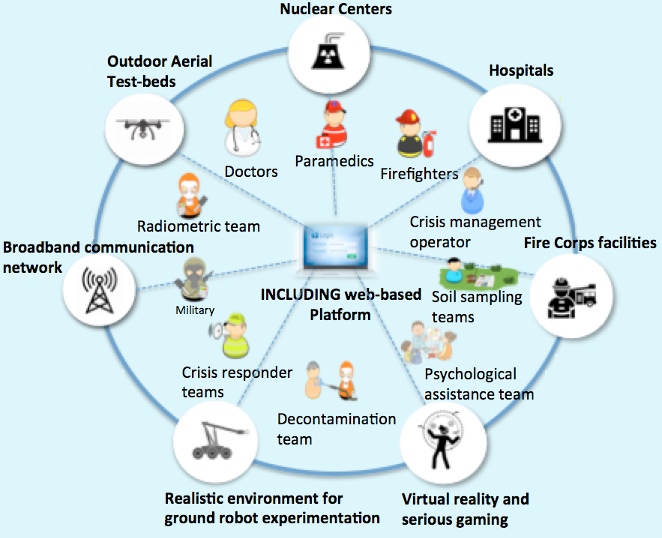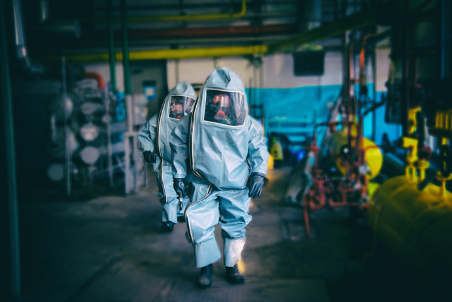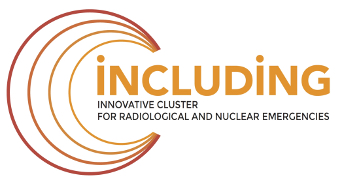By Radoslaw Trawinski, Crisis Management Specialist involved in Security Research Projects
Introduction to INCLUDING Project
The two main focus points for the INCLUDING project include Radiological and Nuclear (RN) threat response training in the EU and their possible functional and technical development. Its realization was laid by European Commission in hands of the consortium composed out of 15 entities from 10 European countries, representing wide range of RN security stakeholders, from industry to institutes and universities. INCLUDING lasts for five years until summer of 2024. Due to the fact that the project has a very specific goal, it can be quite time-consuming and therefore is un-conventionally long. INCLUDING’s main focus is to improve planning and execution of RN crisis response trainings on Pan-European level. It is done in two different ways; firstly giving each stakeholder easy access to a list of approved and available training resources in the EU. Secondly, the development of a common learning framework for RN training which would be adapted in each EU country to support implementation of these new technologies. Both of these initiatives require extensive research, which is one of the main tasks for the first year of the project. INCLUDING partners gather data about RN test and training facilities across Europe in a bid to procure members which would join INCLUDING Federation. This international group of test bed owners and managers will be joined by the experimenters- first responders, experts, decision makers and all other personnel actually interested in using above mentioned test and training infrastructure. The concept of INCLUDING is not limited only to community integration. It is about providing a model, based on user’s gaps and needs analysis, which will provide support to identify the most suitable training resources, provide their detailed characteristics and guide thru the reservation process. Secondly, common learning framework, will be achieved basing on a priceless experience gathered by INCLUDING partners during previous security research projects. Developed standards and properly adapted taxonomies in the area of training plan and evaluation should ensure the proper balance between the possibility to adapt the course to individual needs and the use of systematized training parameters which would be compared with the results achieved in other courses within the Federation. Such a unified learning framework could become a huge step towards better international RN crisis response and cooperation.

Foreseen functionality of INCLUDING Platform
Foreseen functionality of INCLUDING Platform INCLUDING Federation is about to process swathes of big data which would be safely stored and accessible for authorized members. It is a software tool which will be assigned to ensure it will be known as the INCLUDING Platform. It will work as a web cloud-based solution for connecting the Federation members and providing additional functionalities developed within the project. The way it will work with the INCLUDING Platform may differ depending on the role and point of interest of each user. Experimenter, who would like to organize a training will use the Platform to review previous training scenarios published by other members to use it as a reference as well as being a useful source of knowledge and experience to create our own training scenario, identify required resources, book a test bed and equipment and get access to digital test and training tools, invite experts for a training and define training evaluation methodology. Owners of a test bed or any other training tools or infrastructure (including software) using INCLUDING Platform will be able to become involved in trainings organized by Experimenters, invite other users to hosted trainings, promote own resources in the international environment of potential end-users, extend tools capabilities by integrating them with the solutions provided by other partners. Furthermore, experts who would like to take part in RN training who cannot organize it on their own, may use the Platform to join the trainings of other Federation members, with their expectations and capabilities. The INCLUDING Platform is about to cover complete test and training process, not only the phase of organization and planning. During the course, Platform will work as a link for trainees to receive an access to integrated digital tools, such as 3D models and resources management software. Furthermore, it will gather and publish survey values taken by the sensors used in action. At this stage it will be also used by the training evaluators who will make their assessments and add comments directly into the INCLUDING system. As the event closes, the Platform will be a place to gather the evaluation data, summarize the results and publish them in order to provide feedback for future training organizers. Evidently speaking, INCLUDING Platform is not only for integration people, it will also integrate the knowledge, experience and resources, making RN tests and trainings more efficient, systematized, up-to-date and easier to organize and process. From technical and methodological point of view, the Platform may be easily called a HEART of the whole INCLUDING Project.

Joint Actions
Experts, test beds, new technologies, federated model, learning framework, and the Platform is quite a lot for a single project. But how it is going to work during the actual RN tests and trainings? INCLUDING consortium members and other stakeholders are about to experience that during the series of events called Joint Actions (JA). Each JA will be a single RN test or training campaign hosted by one of the training partners, such as ENEA or the City of Mikkeli. Event dates, locations and initial scenarios are already confirmed, however they will be updated and developed in upcoming months accordingly with the results of the research part of the project. In doing so it will consider end-user’s gaps and needs analysis, accessibility of RN training infrastructure, availability of key stakeholders and functionality of the Platform. This tool is very important as it builds the whole framework of each JA. A single event starts from complete planning process within the Platform, considering scenario definition, test bed assignment, identification and booking of other required infrastructure and tools, registration of participants, evaluation methodology and training goals establishment. Final version of this data package will be shared with JA participants in order to enable them to properly prepare for the meeting. During the actual test or training campaign, everyone will realize foreseen activities accordingly to the role assigned for each scenario, working as end-user, tool provider or evaluator. All data gathered by the experimenters and their equipment will be processed by the INCLUDING Platform in order to present the full potential of this tool and confirm its utility. After finalization of all scenarios, JA will end with an evaluation summary which will be a good starting point for an opened discussion of experts about the proper direction from RN threat response trainings development. Feedback gathered during the first events will be utilized for the benefit of future campaigns. JA are about to realize many interesting RN scenarios: from reactor incident to “dirty bomb” attack. If you would like to take part in one of these INCLUDING events, please visit project website and join the Federation for more information.

Summary
As citizens, when nothing wrong happens or other problems trouble our minds, it is easy to forget about the existence of a threat like RN. In many ways this is not a bad thing, as there is no point in living in fear all the time. Nevertheless, there is a difference between being afraid and being aware. Society awareness is one of the goals of the RN trainings and is also considered within the H2020 INCLUDING Project, as properly educated civilians are a huge support to first responders in the time of a big-scale crisis. As you see, there are many groups of RN test and training stakeholders. If you feel that you are one of them, representing firefighters, doctors, technology providers, teachers, decision makers, donors, crisis infrastructure managers, security experts- join the Federation and get INCLUDED!

About the Author
Radoslaw Trawinski graduated from the Warsaw University of Technology with specialization in spatial information systems. Since 2013 he is a Crisis Management Specialist involved in several security research projects (FP7, Horizon 2020, NCBiR) related with CBRNE threat response, humanitarian demining and police operation’s planning. He is responsible for project results presentation & evaluation, trainings management and GIS products delivery. He also organized over a dozen crisis response on-field demonstrations, tabletop exercises, conferences and test campaigns. He is accustomed to work in close cooperation with public services and crisis response end-users.





